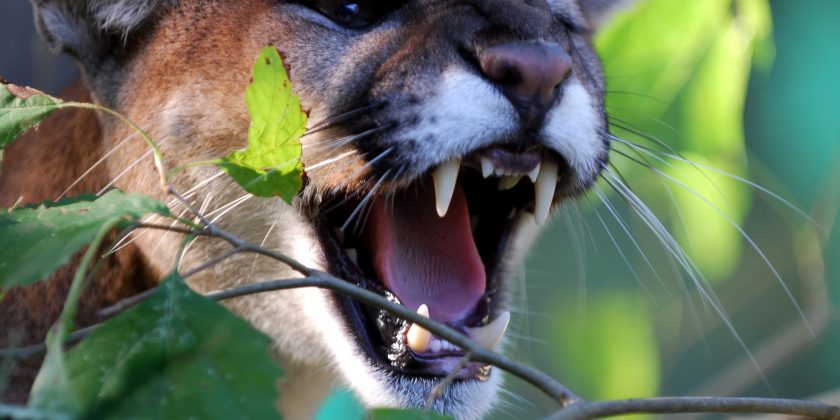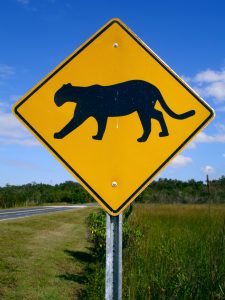Stalking the Florida Panther
The Florida Panther is one of the sub-species of cats known as the Mountain Lion, Puma, or Cougar. The cat is the only variety of sub-species that are known to breed in the eastern section of the United States. The pumas were designated as an endangered species in 1967. Since then, state, federal, and wildlife organizations have been working toward recovering the species.
A Fascinating Sub-Species
 The Florida Panther is Florida’s state animal. The cats have tan coats and blue eyes. The cat’s underside is a creamy, white color. The cats have spots on their coats as kittens that fade as they reach adulthood. Panthers can reach up to 159 pounds at adulthood. The males tend to be larger than the females and reach maturity earlier.
The Florida Panther is Florida’s state animal. The cats have tan coats and blue eyes. The cat’s underside is a creamy, white color. The cats have spots on their coats as kittens that fade as they reach adulthood. Panthers can reach up to 159 pounds at adulthood. The males tend to be larger than the females and reach maturity earlier.
Unlike big cats like lions that roar, panthers make a variety of sounds including:
- Chirps
- Hisses
- Purrs
- Whistles
Panthers are carnivores and survive on alligators, deer, hares, waterfowl, rodents, and wild boar. Deer are more vulnerable to panthers since both species are nocturnal animals.
The Panther Recovery Plan
The U.S. Fish and Wildlife Service will consider removing the cats from the Endangered Species List when 240 of the species, including kittens, have been established, and the cats have a habitat that can support them and their offspring for the long term. The recovery of the species can be successful only with the cooperation of private landowners in areas outside South Florida.
Best Times To Spot A Panther
The best time to see a panther is early in the morning or late in the evening, at the same time the deer come out to feed. Although most people think that the place to spot panthers is in the woods or where there’s a lot of dense underbrush, you may spot one near the water. Panthers are excellent swimmers and have been spotted swimming across a river more than a mile wide.
Regions Panthers Inhabit

Panther-crossing road sign in Florida Everglades National Park.
A lot of people in Florida believe they’ve seen the cats. With so few of them left in the wild, it’s unlikely unless you camp near a specific area including the remote parts of the Big Cypress Everglades area, and Indian and Seminole counties in the central part of the state. Several verified sightings have been reported in these two counties.
Several areas that Florida Panthers are known to inhabit include:
- The eastern section of Everglades National Park
- Bear Island in Big Cypress National Park
- Raccoon Point in Big Cypress National Park
- Fakahatchee Strand
Big Cypress Park RV Camping
Midway Campground in Ochopee is a year-round, RV park and campground that offers 26 RV sites. The park is only one of two parks in Big Cypress open all-year. The campground is located on a lake with clear views from the campsites. If you’re an early bird or enjoy the evening breezes, you may spot one of Florida’s elusive cats near the lake.
Bear Island
Bear Island Campground is in one of the most remote sections of western Big Cypress Park and offers more opportunities for spotting panthers than in parks that are more densely compacted. The park offers 40 primitive RV and tent sites that are accessible from a 20-mile-long gravel road. Note: This is a primitive campground so it isn’t suitable for all RVs, make sure to call the campground to verify accessibility for your rig. There are no hookups at the campground so be prepared to boondock. If you are willing to rough it, however, RV camping in remote parks in Florida provides an excellent opportunity to observe Florida Panthers in the wild.
How To See Florida Panthers
The best chance of seeing a Florida Panther in the wild is in the Florida Panther National Wildlife Refuge. The wildlife refuge 20 miles from Naples comprises 27,000 acres. Between 5 and 11 panthers are spotted in the preserve each month. The sanctuary is 20 miles from Naples and in proximity to Big Cypress National Preserve, Picayune Strand State Forest, and Fakahatchee Strand State Reserve.
The Leslie M. Duncan Memorial Trail is a boardwalk, loop trail that runs among the oak trees and thick brush. Bear, deer, and occasionally panthers have been spotted near the trail. Florida’s Fish and Wildlife Service provides information on wildlife viewing, hiking, and nature photography opportunities.

